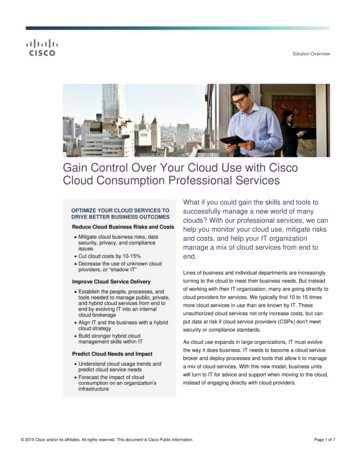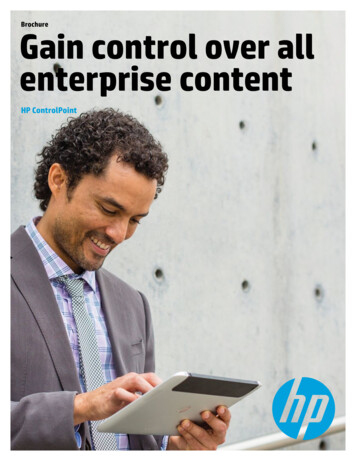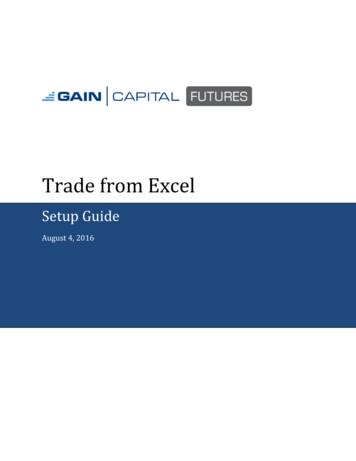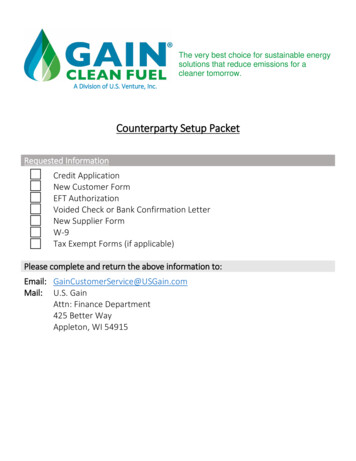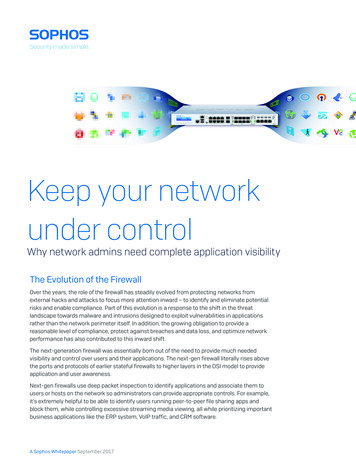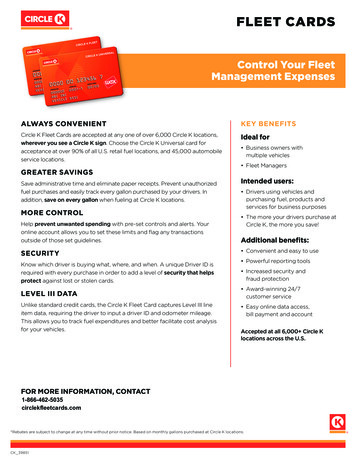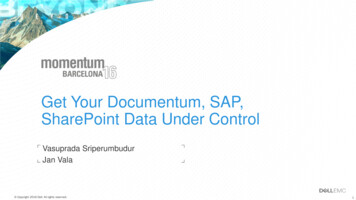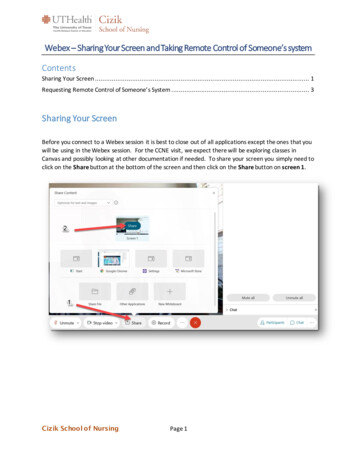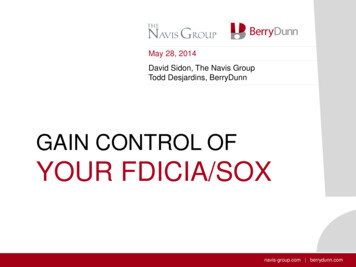
Transcription
May 28, 2014David Sidon, The Navis GroupTodd Desjardins, BerryDunnGAIN CONTROL OFYOUR FDICIA/SOXnavis-group.com berrydunn.com
TODAY’S AGENDAPart 1 - 9:00 to 10:15amPart 2 – 10:30 to 11:45amIntroductions“Rolling COSO Forward”Surveying the RoomHow methodology changes / expandsDefining FDICIA SOX & COSOCurrent best practice for FDICIA / SOXA practical approach – mapping the 87focus points with a renewed emphasison the entity-level and risk objectivesThe external audit firm’s rolePCAOB – what is their role?COSO’s New Guidance (from the COSOslide deck)Q&ABreak2
PRESENTATION MATERIALSVia BerryDunn and The Navis Group (through BASECAMPHQ.com) Today’s Slide Deck The Full COSO Outreach Deck PCAOB – Auditing Standard #5 – “An Audit of Internal Control over FinancialReporting that is Integrated with an Audit of Financial Statements” Rolling COSO Forward (hand-out in PDF format)3
SMALL SAMPLE BASELINE SURVEYBanks Creeping up on FDICIA?Banks Subject to FDICIA?Banks Subject to Sarbanes-Oxley?Who “OWNS” FDICIA/SOX in your institution?CFO - CONTROLLER - RISK - INTERNAL AUDITWho “TESTS” FDICIA/SOX in your institution?OWNERS - RISK - INTERNAL AUDIT - OUTSOURCEDWho should own COSO?4
SMALL SAMPLE BASELINE SURVEY – PART 2Testing as separate “event” or embedded in IA schedule?What’s the Rhythm? Quarterly – Annual – What about Month 12?Excel/Word Based? Custom? Software Solution (e.g., WolfPAC)?Scope - Separate Entity-Level, Technology & Process-Specific Controls?How Tied to Financial Statements – GL Acct Numbers/Groupings? Other?Number of Controls? If more than 125, let’s talk!What’s your testing effort metric? (two - three hours per control per year?)5
FDICIA VS. SOX VS. COSO – IMPORTANT DISTINCTIONSCUTTING THROUGH THE FOG – COMPLIMENTS OF MR. DICKENS“Fog everywhere. Fog up the river, where it flows among green aits and meadows; fog downthe river, where it rolls defiled among the tiers of shipping and the waterside pollutions of agreat (and dirty) city. Fog on the Essex marshes, fog on the Kentish heights. Fog creeping intothe cabooses of collier-brigs; fog lying out on the yards, and hovering in the rigging of greatships; fog drooping on the gunwales of barges and small boats. Fog in the eyes and throats ofancient Greenwich pensioners, wheezing by the firesides of their wards; fog in the stem andbowl of the afternoon pipe of the wrathful skipper, down in his close cabin; fog cruellypinching the toes and fingers of his shivering little ’prentice boy on deck. Chance people onthe bridges peeping over the parapets into a nether sky of fog, with fog all round them, as ifthey were up in a balloon, and hanging in the misty clouds.”Paragraph #2 - Bleak House, by Charles Dickens6
FDICIA VS. SOX VS. COSO – IMPORTANT DISTINCTIONSFDICIAFDICIA (the FDIC Improvement Act of 1991, as amended) in part, requires bankswith assets exceeding 1 billion to assert that an internal control methodology is inplace to assure the integrity of the annual audited financial statements, as well asthe four quarterly Call Reports.The “measurement” date for asset size is the fiscal year-end, necessitatingcompliance the following year.7
FDICIA VS. SOX VS. COSO – IMPORTANT DISTINCTIONSSOXSOX (the Sarbanes-Oxley Act of 2002) is a non-industry specific compliancerequirement for all SEC registrants (those filing Qs and Ks).SOX was born of the Enron era. SOX roll-out and enforcement was troublesomenationwide, as the effective date and metrics for small versus large companies wasregularly postponed and amended. Years passed. The “measure” for thiscompliance requirement is a market capitalization level of 75 million (i.e., when“accelerated filer” status is attained). The “measurement” date for capitalizationlevels is June 30, necessitating compliance in the fiscal year ending after such date.SOX compliance extends the scope of financial reporting to include the quarterlyfilings (but currently not the proxy information).8
FDICIA VS. SOX VS. COSO – IMPORTANT DISTINCTIONSCOSOThe Committee of Sponsoring Organizations is a collaborative effort of the AmericanAccounting Association, AICPA, Financial Executives International, The Association ofAccountants and Financial Professionals in Business, and the Institute of InternalAuditors (IIA).COSO is the source of suggested methodology for both SOX and FDICIA, and althoughnot dictated by the FDIC, has become accepted as best practice throughout the bankingindustry. It is important to be clear that COSO is not a regulatory or enforcementagency.COSO’s salient document dates to 1992, with a preponderance of additional workingtools over the past 20 years. In 2013, COSO rolled out an updated document that takeseffect 12/15/14. COSO 2013 will need to be in effect for 12/31/14 assertions.9
FDICIA 101 Holdings at 1 billion level, necessitating FDICIA compliance by year-end Overall, financial reporting controls are the sole focus of FDICIA compliance Law requires “assertion” by CEO and CFO that control structure has integrity Yes! Is the answer to the question “do you have sacred, well-documentedcontrols?” Starting point is a comprehensive process map of the institution High risk, significant financial reporting vulnerabilities need to be identified Internal control objectives and auditable evidence must be clearly articulated Testing, testing, testing10
FDIC SAYS “COSO IS SUITABLE”“In the United States, Internal Control—Integrated Framework, including itsaddendum on safeguarding assets, which was published by the Committee ofSponsoring Organizations of the Treadway Commission, and is known as the COSOreport, provides a suitable and recognized framework for purposes ofmanagement’s assessment. Other suitable frameworks have been published inother countries or may be developed in the future. Such other suitableframeworks may be used by management and the institution’s independent publicaccountant in assessments, attestations, and audits of internal control overfinancial reporting.”11
COSO’S TIMINGThroughout this multi-year project, the COSO Board has emphasized that the keyconcepts and principles embedded in the original Framework remainfundamentally sound for designing, implementing, and maintaining systems ofinternal control and assessing their effectiveness.Therefore, COSO will continue to make the original Framework available throughDecember 15, 2014, at which time the 1992 Framework will be consideredsuperseded. During this transition period—today through December 15, 2014—COSO believes continued use of the 1992 Framework is acceptable. Entitiesleveraging COSO’s Internal Control—Integrated Framework for external reportingpurposes during the transition period, however, should clearly disclose whetherthey used the 1992 or 2013 version.12
REPORTING DEFICIENCIES - HERE’S WHAT A “BAD” EXTERNAL AUDIT LOOKS LIKEWould we want to include this kind of language in our annual report? We did not maintain effective company-level controls Our control environment did not sufficiently promote integrity and ethical values over financial reporting We had inadequate monitoring controls, including inadequate staffing and procedures There was inadequate communication from management to employees regarding the importance ofcontrols and employees’ duties and control responsibilities We had inadequate procedures and controls to ensure proper segregation of duties We had inadequate policies, procedures, and personnel to ensure that accurate, reliable interim, andannual financial statements were prepared and reviewed We had insufficient levels of supporting documentation We had inadequate review procedures over account reconciliations Our review procedures over accounting for revenue recognition were not functioning effectively As a result of these material weaknesses in the Company’s internal control over financial reporting,management has concluded that the Company’s internal control over financial reporting was not effectiveThe company: Central Parking Corporation – 12/31/05 10-K filing with SEC – all of the above required to beincluded in their annual report to shareholders!13
BEST PRACTICE METHODOLOGY PRE-COSO-2013IDENTIFY PROCESSES “TOUCHING” FINANCIAL REPORTING“CULL” OUT INSIGNIFICANT PROCESS AND ID RISKS/CONTROLSFINANCIAL STATEMENT LINKAGE (BY OBJECTIVE NOT GL #)EXAMPLE:INVESTMENTS – 4 REPORTING OBJECTIVES TRANSACTIONS AUTHORIZED ACCURATE AND COMPLETE RECORDING SAFEKEEPING VALUED CORRECTLY14
THE CLARITY OF ARTICULATION – CUSSRISK AND CONTROL NARRATIVES SHOULD BE ARTICULATED CAREFULLY AND CLEARLYAN APPLE PIE ANALOGYC.U.S.S.Clear – Unambiguous – Succinct - Supportable15
ASK TOUGH QUESTIONSFrom Billy Collins collection “Sailing Alone Around the Room”, and a poem entitled “I ChopSome Parsley While Listening to Art Blakey’s Version of Three Blind Mice”:And I start wondering how they came to be blindIf it was congenital, they could be brothers and sistersOr was it a common accident, all three caught perhaps in a searing explosion, fireworksperhaps?If not, if each came to their blindness separately, how did they ever manage to find oneanother?Would it not be difficult for a blind mouse to locate even one fellow mouse with vision, letalone two other blind ones?All good questions, wouldn’t you agree?16
ALL THE ELEMENTS OF RISK IDENTIFICATION IN 1 SONG TITLEOh My God, The Bar’s on Fire, Somebody Save the BeerBy the Bottle RocketsRisk Identification – Oh My God, The Bar’s on FireRisk Articulation – The Bar’s on FireOwnership – SomebodyRisk Remediation – Save the BeerAll that’s missing is the control statementFind the Risk – Articulate how it is Controlled17
CLARITY AS AN AID TO TESTING SIMPLIFICATIONMission of “tester” is not to re-audit whether the transaction is correctMission is to test if controls are “sacredly” deployedThe difference between internal audit and controls testingAUDIT VS. TEST18
KEY CONTROLS ONLY – RISK-WEIGHTEDThe risk rating is easy. If our control fails, here’s a handyscale to measure your CEO’s reactionL Low-key, Laid BackM Mad, MiffedH Hot, Horrified, Hysterical19
EXTERNAL AUDIT ROLE AND VIEWPOINT Fraud risk assessment considerations Auditor’s role with bank implementation Auditor’s opinion on internal control over financial reporting (ICFR)20
FRAUD RISK ASSESSMENT CONSIDERATIONS Plan and coordinate What could go wrongo Types of Fraudo Factors impacting fraud risko Management override of controls Design and implement Test effectiveness of controls Ongoing Monitoring21
AUDITOR’S ROLE Educate – audit committees, internal audit, and management Implementation and external audit timeline Evaluate design (2nd and 3rd quarter) Complete interim testing (4th quarter) Roll forward interim testing and report on ICFR (12/31 thru fieldwork)22
AUDITOR’S RESPONSIBILITY Test internal controls over financial reporting Opine on internal controls over financial reporting (integrated audit) AT 501 404(b) – public float over 75 million Report material weaknesses in ICFR23
ROLLING COSO FORWARDWhat has really changed?Expansion of relative financial reporting “vehicles”?Should we focus on internal reporting as well?Added emphasis on risk and fraud (example on following slide)Added emphasis on entity-level integrity via specific focus pointsDo we map to the 87 focus points?24
EMPHASIS ON PERFORMANCEIn the accountability objective: Performance Measures Established Performance Measures Evaluated Performance Pressures Considered Performance Rewarded / DisciplinedIn the fraud potential objective: Incentives / Pressures Considered Fraud Opportunities Considered Fraud "Environment" Assessed25
COSO’S 17 OBJECTIVESControl Environment1. The organization demonstrates a commitment to integrity and ethical values.2. The board of directors demonstrates independence from management andexercises oversight of the development and performance of internal control.3. Management establishes, with board oversight, structures, reporting lines, andappropriate authorities and responsibilities in the pursuit of objectives.4. The organization demonstrates a commitment to attract, develop, and retaincompetent individuals in alignment with objectives.5. The organization holds individuals accountable for their internal controlresponsibilities in the pursuit of objectives.26
COSO’S 17 OBJECTIVESRisk Assessment6. The organization specifies objectives with sufficient clarity to enable theidentification and assessment of risks relating to objectives.7. The organization identifies risks to the achievement of its objectives across theentity and analyzes risks as a basis for determining how the risks should bemanaged.8. The organization considers the potential for fraud in assessing risks to theachievement of objectives.9. The organization identifies and assesses changes that could significantly impactthe system of internal control.27
COSO’S 17 OBJECTIVESControl Activities10. The organization selects and develops control activities that contributetothe mitigation of risks to the achievement of objectives to acceptable levels.11. The organization selects and develops general control activities overtechnology to support the achievement of objectives.12. The organization deploys control activities through policies that establish whatis expected and in procedures that put policies into action.28
COSO’S 17 OBJECTIVESInformation and Communication13. The organization obtains or generates and uses relevant, quality information tosupport the functioning of other components of internal control.14. The organization internally communicates information, including objectivesand responsibilities for internal control, necessary to support the functioningof other components of internal control.15. The organization communicates with external parties regarding mattersaffecting the functioning of other components of internal control.29
COSO’S 17 OBJECTIVESMo
Current best practice for FDICIA / SOX . The external audit firm’s role . COSO’s New Guidance (from the COSO slide deck) Break . 2 . Part 2 – 10:30 to 11:45am How methodology changes / expands A practical approach – mapping the 87 focus points with a renewed emphasis on the entity-level and risk objectives . PCAOB – what is their role? Q & A . PRESENTATION MATERIALS . Via BerryDunn .
